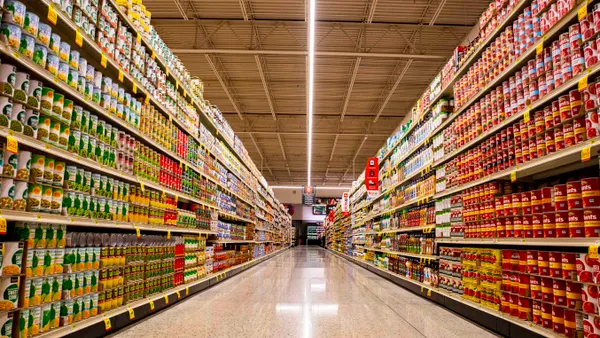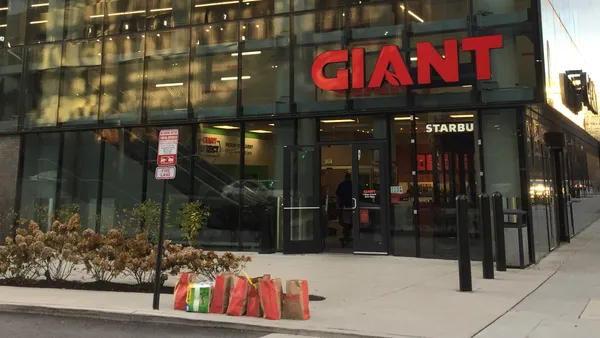Dive Brief:
- Kroger reported same-store sales growth excluding fuel of 2.2% for the second quarter of fiscal 2019 — its strongest performance in the key metric since its Restock Kroger initiative kicked off two years ago. Adjusted earnings per share grew 7% to 44 cents, which beat analyst estimates of 40 cents. Gross margin was close to 22% of sales and its FIFO gross margin rate dropped 29 basis points, which the company contributes to industry-wide lower gross margin rates, particularly in pharmacy.
- During the company's earnings call, CEO Rodney McMullen said Kroger no longer expects to hit its target of $400 million in incremental profit by 2020 — an adjustment in its turnaround strategy that sent shares tumbling as much as 6%.
- Krogers' store brand sales increased by 3.1% over the year-ago period while digital sales grew 31%. Looking ahead, Kroger reiterated its 2019 full-year outlook on EPS guidance of $2.15 to $2.25 and same-store sales growth of 2% to 2.25%. Analysts are expecting its full-year EPS to be $2.17.
Dive Insight:
While Kroger's same-store sales, which accelerated across 15 store divisions, provided a much-needed boost for the company, its profit adjustment underscores just how difficult it is to change course while at the same time battling intense industry competition.
"Transformation is incredibly difficult," McMullen said during Kroger's earnings call Thursday morning.
McMullen and Kroger chief financial officer Gary Millerchip acknowledged ongoing costs associated with its Restock Kroger turnaround plan along a low-performing pharmacy division as impediments to growth. They also said the company's same-store sales, while strong this latest quarter, have taken longer than expected to accelerate.
McMullen said the company will offer further details on its long-term guidance during the company's investors day presentation November 5.
During Q2, Kroger launched 203 new store brand products and began rolling out its new Simple Truth Plant Based line, which features hundreds of meat-free and dairy-free products. It also expanded grocery pickup service to 1,780 locations and now offers delivery from 2,225 locations, altogether covering about 95% of Kroger’s households.
Kroger's digital investments are necessary to keep pace with Walmart, Amazon and Target. But these investments are proving a drag on quarterly and yearly earnings. Last year the company experienced a 19.7% drop in operating profits, and while the company has increased operating profits by 1.8% this quarter, Neil Saunders, managing director at GlobalData Retail, expects margins to keep taking hits.
“Looking ahead, our concern with digital is not that the market will get more crowded and competitive, it is that an increased focus on low-cost and free delivery options as well as price competition on products will accelerate margin attrition,” Saunders wrote in a note emailed to Grocery Dive. “Kroger will need to manage this carefully as, for the most part, it does not have the ballast of stronger non-food margins that players like Target and Walmart do.”
Kroger is also pouring money into store resets in line with its data forecasts. But Saunders believes stores could use further remodeling, particularly its banner locations.
"While there is a modest ongoing refurbishment program, we still believe that too many stores under Kroger’s various banners are dispiriting and in desperate need of investment," he wrote.












